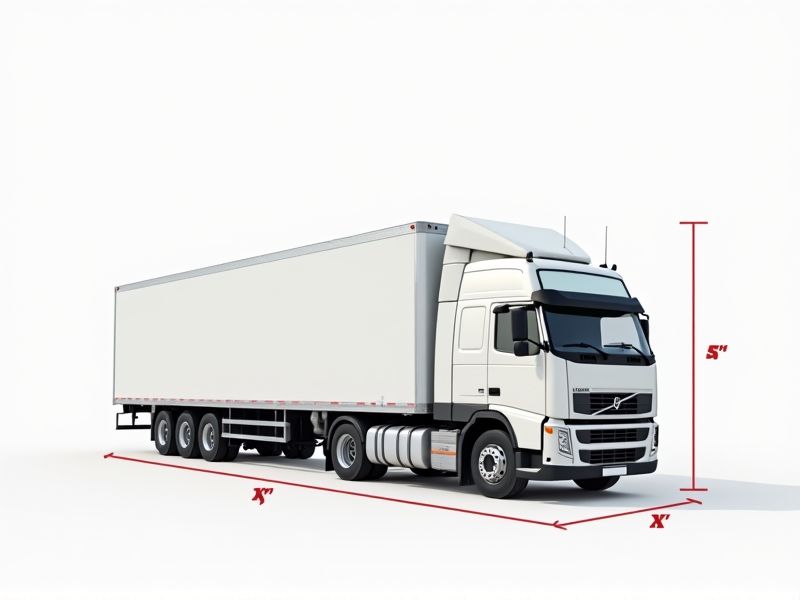
When planning for freight or managing logistics, knowing the standard dimensions of a tractor-trailer can save you time and prevent costly mistakes. A typical tractor-trailer in the United States measures about 53 feet long, 8.5 feet wide, and 13.5 feet high. This size provides approximately 3,489 cubic feet of cargo space, helping you estimate how much inventory can fit inside. Always confirm these measurements with your carrier, as dimensions may vary based on type, region, or specific shipment needs.
Overall Length
The standard overall length for tractor-trailers in the United States is typically 65 feet, although specific limits can vary by state. This measurement includes both the tractor and the trailer, ensuring optimal maneuverability and stability on highways. When considering weight limits, a typical maximum gross vehicle weight (GVW) for these vehicles is 80,000 pounds, which encompasses the total weight of the truck and cargo. Understanding these standards is essential for compliance and efficient transport logistics.
Width
The standard width for tractor-trailers in the United States typically measures 102 inches, or 8.5 feet, allowing for optimal maneuverability on highways and roads. This width accommodates various cargo types while ensuring compliance with federal regulations aimed at safety and stability during transport. In specific states, special permits may allow wider trailers, reaching up to 120 inches, but these are subject to strict guidelines. Ensuring your tractor-trailer adheres to these width standards is essential for avoiding fines and facilitating efficient road travel.
Height
Tractor-trailers typically feature a standard height of approximately 13 feet 6 inches (4.1 meters), a measurement crucial for ensuring compliance with height restrictions on roadways and bridges. This height allows for optimal cargo capacity while also accommodating various transportation regulations across different states. You must consider that exceeding this height may result in fines or mandated route adjustments. Variations exist based on specific truck configurations, but maintaining standard height is essential for safe and legal travel.
Wheelbase
A tractor-trailer typically features a wheelbase ranging from 18 to 30 feet, significantly influencing its handling and stability. An extended wheelbase offers enhanced load distribution, resulting in improved traction and safer maneuverability, especially when navigating sharp turns. For drivers, understanding the wheelbase is crucial, as it affects turning radius and overall vehicle control. Proper wheelbase measurement is also essential for compliance with road regulations, including weight limits and bridge clearance requirements.
Turning Radius
The standard turning radius of a tractor-trailer typically measures between 50 to 60 feet, which is critical for navigating tight spaces and urban environments. This measurement is influenced by factors such as wheelbase length, axle configuration, and overall vehicle size. A tighter turning radius enhances maneuverability, allowing truck drivers to make sharp turns without encroaching onto adjacent lanes or sidewalks, thus improving safety. Understanding your vehicle's turning radius is essential for effective route planning and reducing the risk of accidents during delivery operations.
Gross Vehicle Weight
The Gross Vehicle Weight Rating (GVWR) for tractor-trailers is a crucial metric, typically ranging from 26,000 pounds to 80,000 pounds, depending on the vehicle configuration and state regulations. This weight encompasses the tractor, the trailer, and the maximum load it can carry, ensuring safety and compliance with transportation standards. Exceeding the GVWR can lead to costly fines and increased wear on vehicle components, significantly affecting your operational efficiency. Understanding and adhering to the GVWR not only ensures legal compliance but also contributes to safer roadways and reduced risk of accidents.
Load Capacity
Tractor-trailers typically hold a load capacity ranging from 26,000 to 80,000 pounds, depending on federal regulations and specific vehicle configurations. This significant load capacity is crucial for transporting various goods over long distances, improving logistics and supply chain efficiency. Understanding your tractor-trailer's gross vehicle weight rating (GVWR) helps ensure you're operating within safety standards and legal limits. Regular maintenance and weight checks can enhance performance and extend the lifespan of your equipment under these demanding loads.
Axle Spacing
Axle spacing is crucial in determining the load distribution and overall stability of a tractor-trailer. A common standard for axle spacing in combination vehicles is 36 inches between the first and second axle, optimizing weight distribution for maximum efficiency and safety. Many states require a minimum axle spacing of 34 inches to comply with bridge formula weight limits, which prevents excessive wear on road infrastructure. By adhering to these regulations, you ensure not only compliance but also improved handling and reduced fuel consumption during transport operations.
Ground Clearance
Ground clearance for standard tractor-trailers typically ranges between 14 to 18 inches, allowing for optimal navigation across various terrains. This measurement is crucial for preventing damage to the undercarriage while ensuring stability during transport. Many models also incorporate adjustable suspension systems, offering the ability to modify ground clearance based on load capacity or road conditions. When selecting a tractor-trailer, considering the ground clearance is essential for maintaining efficiency and safety on your routes.
Deck Length
The standard deck length for tractor-trailers typically ranges between 48 and 53 feet, making them suitable for a variety of cargo types. In the U.S., most states allow a maximum overall vehicle length of 65 feet for tractor-trailer combinations, including the tractor and the trailer. It's crucial for your logistics planning to consider these dimensions for optimal load management and compliance with transportation regulations. Choosing the right deck length can maximize payload efficiency and reduce transportation costs, ensuring that your operations remain competitive.
